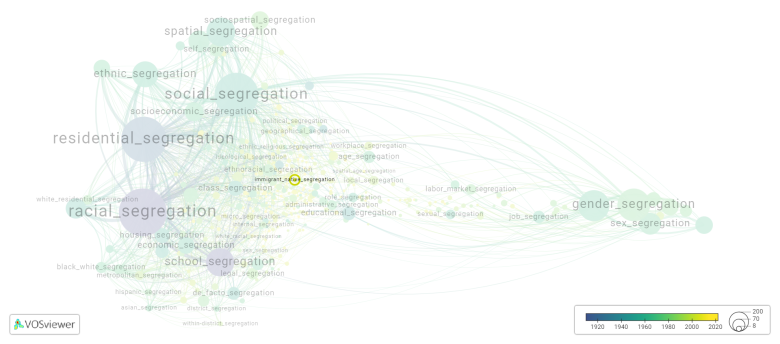Immigrant native segregation
Date and country of first publication[1]
2014
Germany
Definition
Immigrant-native segregation refers to the separation and division of immigrant communities from the native population within a society. This can occur on various levels, including residential, educational, and social segregation.
Residential segregation happens when immigrants predominantly live in certain neighborhoods or areas, separate from the native population. This can occur due to economic factors, discrimination, or cultural preferences. The concentration of immigrants in specific neighborhoods can lead to limited interaction and social integration between immigrant and native communities.
Educational segregation occurs when immigrant students are predominantly enrolled in schools separate from their native counterparts. This can happen due to language barriers, lack of resources, or institutional policies. Such segregation can hinder the educational opportunities and social integration of immigrant students.
Social segregation refers to the division and limited interaction between immigrant and native communities in social settings. This can occur due to cultural differences, language barriers, or prejudice and discrimination. Immigrants may face challenges in accessing job opportunities, social networks, and services, which can further perpetuate their isolation from the native population.
Immigrant-native segregation can have negative consequences for both immigrant communities and the larger society. It can hinder social cohesion, promote stereotypes, and create inequalities in access to resources and opportunities. Integration efforts, such as inclusive housing policies, language support programs, and anti-discrimination measures, can help address and reduce immigrant-native segregation.
See also
Related segregation forms
Immigrant native segregation is frequently discussed in the literature with the following segregation forms:
racial segregation, immigrant segregation, workplace segregation, social segregation, ethnic segregation

This visualization is based on the study The Multidisciplinary Landscape of Segregation Research.
For the complete network of interrelated segregation forms, please refer to:
References
Notes
- ↑ Date and country of first publication as informed by the Scopus database (December 2023).
Immigrant native segregation appears in the following literature
Windzio M., Wingens M. (2014). Religion, friendship networks and home visits of immigrant and native children. Acta Sociologica (United Kingdom), 57(1), 59-75. https://doi.org/10.1177/0001699313481226
Marcińczak S., Tammaru T., Strömgren M., Lindgren U. (2015). Changing patterns of residential and workplace segregation in the Stockholm metropolitan area. Urban Geography, 36(7), 969-992. Routledge.https://doi.org/10.1080/02723638.2015.1012364
Marcińczak S., Bernt M. (2021). Immigration, segregation and neighborhood change in Berlin. Cities, 119(), -. Elsevier Ltd.https://doi.org/10.1016/j.cities.2021.103417
